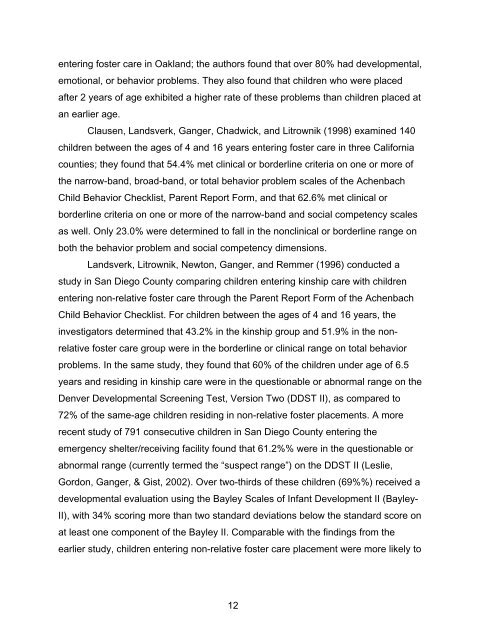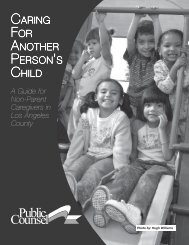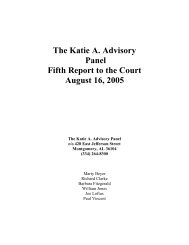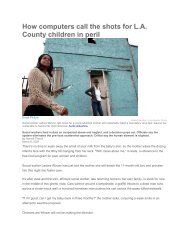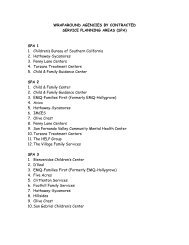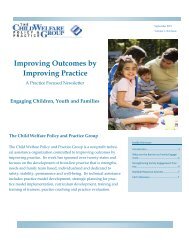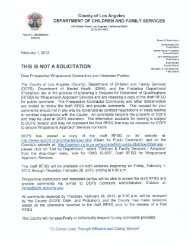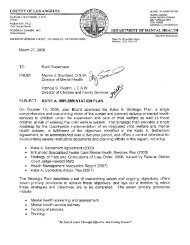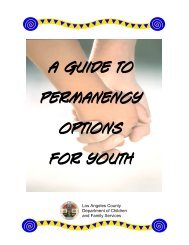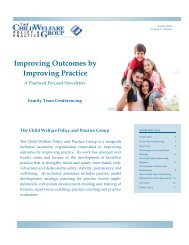Mental Health Care for Children and Adolescents in Foster Care ...
Mental Health Care for Children and Adolescents in Foster Care ...
Mental Health Care for Children and Adolescents in Foster Care ...
Create successful ePaper yourself
Turn your PDF publications into a flip-book with our unique Google optimized e-Paper software.
enter<strong>in</strong>g foster care <strong>in</strong> Oakl<strong>and</strong>; the authors found that over 80% had developmental,<br />
emotional, or behavior problems. They also found that children who were placed<br />
after 2 years of age exhibited a higher rate of these problems than children placed at<br />
an earlier age.<br />
Clausen, L<strong>and</strong>sverk, Ganger, Chadwick, <strong>and</strong> Litrownik (1998) exam<strong>in</strong>ed 140<br />
children between the ages of 4 <strong>and</strong> 16 years enter<strong>in</strong>g foster care <strong>in</strong> three Cali<strong>for</strong>nia<br />
counties; they found that 54.4% met cl<strong>in</strong>ical or borderl<strong>in</strong>e criteria on one or more of<br />
the narrow-b<strong>and</strong>, broad-b<strong>and</strong>, or total behavior problem scales of the Achenbach<br />
Child Behavior Checklist, Parent Report Form, <strong>and</strong> that 62.6% met cl<strong>in</strong>ical or<br />
borderl<strong>in</strong>e criteria on one or more of the narrow-b<strong>and</strong> <strong>and</strong> social competency scales<br />
as well. Only 23.0% were determ<strong>in</strong>ed to fall <strong>in</strong> the noncl<strong>in</strong>ical or borderl<strong>in</strong>e range on<br />
both the behavior problem <strong>and</strong> social competency dimensions.<br />
L<strong>and</strong>sverk, Litrownik, Newton, Ganger, <strong>and</strong> Remmer (1996) conducted a<br />
study <strong>in</strong> San Diego County compar<strong>in</strong>g children enter<strong>in</strong>g k<strong>in</strong>ship care with children<br />
enter<strong>in</strong>g non-relative foster care through the Parent Report Form of the Achenbach<br />
Child Behavior Checklist. For children between the ages of 4 <strong>and</strong> 16 years, the<br />
<strong>in</strong>vestigators determ<strong>in</strong>ed that 43.2% <strong>in</strong> the k<strong>in</strong>ship group <strong>and</strong> 51.9% <strong>in</strong> the nonrelative<br />
foster care group were <strong>in</strong> the borderl<strong>in</strong>e or cl<strong>in</strong>ical range on total behavior<br />
problems. In the same study, they found that 60% of the children under age of 6.5<br />
years <strong>and</strong> resid<strong>in</strong>g <strong>in</strong> k<strong>in</strong>ship care were <strong>in</strong> the questionable or abnormal range on the<br />
Denver Developmental Screen<strong>in</strong>g Test, Version Two (DDST II), as compared to<br />
72% of the same-age children resid<strong>in</strong>g <strong>in</strong> non-relative foster placements. A more<br />
recent study of 791 consecutive children <strong>in</strong> San Diego County enter<strong>in</strong>g the<br />
emergency shelter/receiv<strong>in</strong>g facility found that 61.2%% were <strong>in</strong> the questionable or<br />
abnormal range (currently termed the “suspect range”) on the DDST II (Leslie,<br />
Gordon, Ganger, & Gist, 2002). Over two-thirds of these children (69%%) received a<br />
developmental evaluation us<strong>in</strong>g the Bayley Scales of Infant Development II (Bayley-<br />
II), with 34% scor<strong>in</strong>g more than two st<strong>and</strong>ard deviations below the st<strong>and</strong>ard score on<br />
at least one component of the Bayley II. Comparable with the f<strong>in</strong>d<strong>in</strong>gs from the<br />
earlier study, children enter<strong>in</strong>g non-relative foster care placement were more likely to<br />
12


